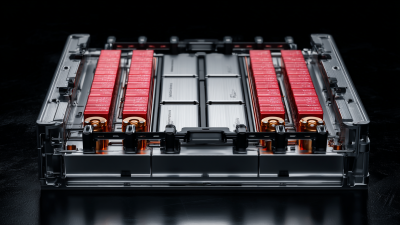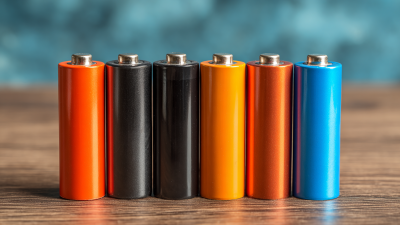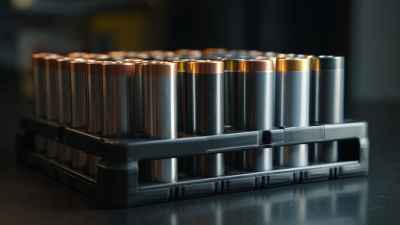How to Optimize the Performance of Your 51.2v Lifepo4 Battery
Table of Contents
- Understanding the Basics of 51.2V Lifepo4 Battery Performance
- Best Practices for Charging Your 51.2V Lifepo4 Battery Efficiently
- Monitoring and Maintaining Optimal Temperature for Battery Health
- Strategies for Extending the Lifespan of Your 51.2V Lifepo4 Battery
- Common Mistakes to Avoid for Enhanced Battery Performance
- Upgrading Battery Management Systems for Improved Efficiency
- FAQS
- Conclusion
- Related Posts
 In the rapidly evolving world of energy storage solutions, the importance of optimizing the performance of a 51.2V Lifepo4 Battery cannot be overstated. As highlighted in recent industry reports, Lifepo4 batteries have become a preferred choice for various applications, such as household energy storage and electric vehicles, due to their safety features, long cycle life, and environmental benefits.
Roofer Electronics Technology (Shanwei) Co., Ltd., with over 27 years of experience in R&D, manufacturing, and solution services for lithium batteries and energy storage systems, recognizes the significance of maximizing battery efficiency and lifespan.
According to the latest market analysis, the global lithium battery market is projected to reach $92 billion by 2025, emphasizing the growing demand for high-performance battery solutions. This article will explore effective strategies to enhance the functionality and longevity of your 51.2V Lifepo4 Battery, ensuring you make the most of this advanced technology.
In the rapidly evolving world of energy storage solutions, the importance of optimizing the performance of a 51.2V Lifepo4 Battery cannot be overstated. As highlighted in recent industry reports, Lifepo4 batteries have become a preferred choice for various applications, such as household energy storage and electric vehicles, due to their safety features, long cycle life, and environmental benefits.
Roofer Electronics Technology (Shanwei) Co., Ltd., with over 27 years of experience in R&D, manufacturing, and solution services for lithium batteries and energy storage systems, recognizes the significance of maximizing battery efficiency and lifespan.
According to the latest market analysis, the global lithium battery market is projected to reach $92 billion by 2025, emphasizing the growing demand for high-performance battery solutions. This article will explore effective strategies to enhance the functionality and longevity of your 51.2V Lifepo4 Battery, ensuring you make the most of this advanced technology.
Understanding the Basics of 51.2V Lifepo4 Battery Performance
When optimizing the performance of a 51.2V LiFePO4 battery, it's crucial to understand the fundamental aspects that influence its efficiency and longevity. These batteries are celebrated for their stability, safety, and long cycle life, making them ideal for applications in renewable energy systems and electric vehicles. Notably, ongoing innovations in solid-state electrolytes can potentially enhance the performance of such batteries, offering faster charging times and improved energy density.
Tips for enhancing battery performance include regularly monitoring temperature, as extreme heat can degrade battery efficiency. Additionally, maintaining proper charge cycles is essential; it is best to avoid letting the battery discharge completely. Keeping the battery within its optimal voltage range can further extend its life, ensuring that it delivers maximum power when needed.
Moreover, advances in material science, such as the integration of cross-linked strategies in solid-state batteries, can play a pivotal role in future developments. As research progresses, implementing new technologies can substantially improve the overall performance and reliability of LiFePO4 batteries, aligning with the growing demand for more efficient energy solutions.
Best Practices for Charging Your 51.2V Lifepo4 Battery Efficiently
Efficient charging practices for your 51.2V LiFePO4 battery can significantly enhance its performance and lifespan. Recent industry reports highlight that proper charging methods can improve battery cycle life by up to 50%. One of the best practices is to use a dedicated LiFePO4 charger that maintains the optimal charging voltage and current, which should ideally be between 0.5C to 1C for standard charging rates. This careful attention to charging parameters can ensure that the battery remains safe and operates effectively.
Tips for optimal charging include avoiding full discharges and charging your battery when it reaches around 20-30% capacity to maintain its health. It’s also essential to keep the charging environment cool and dry, as high temperatures can lead to accelerated degradation of battery components. Furthermore, utilizing smart charging technology allows for constant monitoring and adjustment of charging characteristics, ensuring the battery operates efficiently while safeguarding it against potential overcharging.
For those in the field, leveraging the latest advancements in LiFePO4 technology can lead to sustainable energy solutions that not only improve performance but also reduce environmental impacts. Embracing these innovations is crucial for maximizing the efficiency and lifecycle of your 51.2V battery system.
How to Optimize the Performance of Your 51.2v Lifepo4 Battery - Best Practices for Charging Your 51.2V Lifepo4 Battery Efficiently
| Best Practices | Description | Optimal Range | Frequency |
|---|---|---|---|
| Charge Cycles | Limit charging to 50% - 80% capacity to extend battery lifespan. | 50% - 80% | Every Cycle |
| Charging Voltage | Maintain charging voltage between 57.6V to 58.4V for optimal performance. | 57.6V - 58.4V | Every Charge |
| Temperature Management | Keep battery in a temperature range of 0°C to 45°C during charging. | 0°C - 45°C | Continuous |
| Smart Charger Use | Use chargers designed specifically for LiFePO4 batteries to enhance safety and efficiency. | N/A | Each Charge |
| Regular Maintenance | Perform regular checks on connections and battery condition to prevent issues. | N/A | Monthly |
Monitoring and Maintaining Optimal Temperature for Battery Health
To optimize the performance of your 51.2v Lifepo4 battery, maintaining an optimal temperature is crucial. Temperature fluctuations can significantly affect battery efficiency and lifespan, especially under real-world conditions. Research indicates that lithium-ion batteries, including Lifepo4 variants, experience reduced capacity and increased degradation when exposed to extreme heat or cold. With recent developments in battery thermal management systems, integrating IoT sensors and machine learning can aid in real-time monitoring, predicting battery thermal behavior, and ensuring that the battery operates within a safe temperature range.
Tips: Regularly check the ambient temperature where your battery is stored or used. Ideally, Lifepo4 batteries should be kept between 20°C to 25°C for optimal performance. Additionally, using advanced diagnostic tools can help in assessing battery health and identifying potential issues before they lead to significant problems.
Investing in predictive maintenance solutions can keep your battery system healthy. By utilizing AI diagnostics and real-time monitoring technologies, as highlighted in industry reports, you can improve battery lifespan and safety. Implementing such technologies can detect early signs of thermal stress, enabling proactive measures to prevent overheating and enhance overall performance.
Strategies for Extending the Lifespan of Your 51.2V Lifepo4 Battery
To extend the lifespan of your 51.2V lithium iron phosphate (LiFePO4) battery, it’s crucial to implement several effective strategies. These batteries are known for their stability and longevity, but environmental factors and usage patterns can significantly affect their performance. One primary method to prolong battery life is to maintain an appropriate charge level. Keeping the battery charged between 20% and 80% can protect it from stress and degradation over time.
**Tips:** Regularly monitor the battery's temperature. Extreme temperatures can hasten wear, so ensure it operates within optimal ranges. Additionally, using a high-quality inverter that matches the power output specifications of the battery can prevent overloading and enhance efficiency.
Another important factor is understanding the discharge rates. High discharge rates can lead to rapid capacity loss. If your application allows, consider using a lower discharge rate to help maintain capacity. Moreover, incorporating a balanced charging routine helps to ensure that all cells within the battery maintain uniform voltage levels, further extending the battery's lifespan. With these practices, you can ensure that your 51.2V LiFePO4 battery performs optimally for years to come.

Common Mistakes to Avoid for Enhanced Battery Performance
When it comes to optimizing the performance of your 51.2V LiFePO4 battery, avoiding common mistakes can significantly enhance its longevity and efficiency. One major mistake is neglecting proper charging practices. According to a report by Battery University, improperly charging lithium batteries can lead to decreased capacity over time. It’s crucial to use a charger that matches the specific voltage and current requirements of your LiFePO4 battery, as overcharging can cause thermal runaway, shortening the battery's lifespan.

Another common pitfall is failing to maintain optimal operating temperatures. Research indicates that exposing lithium batteries to high temperatures can accelerate degradation and reduce performance by over 20% in extreme conditions. Ideally, LiFePO4 batteries should be stored and operated within a temperature range of 0°C to 45°C (32°F to 113°F). Investing in proper thermal management systems can mitigate these risks, ensuring that your battery operates efficiently while extending its useful life. By being vigilant about these aspects, users can maximize the potential of their 51.2V LiFePO4 batteries.
Upgrading Battery Management Systems for Improved Efficiency
Upgrading the Battery Management System (BMS) of 51.2V LiFePO4 batteries is crucial for enhancing their overall efficiency and lifespan. A well-designed BMS not only balances the charge among cells but also monitors their temperature and voltage, thus optimizing performance. Reports indicate that an effective BMS can improve energy efficiency by up to 30%, enabling longer runtime and better safety features. In the wake of software updates that have destabilized other devices' battery performances, it becomes evident how significant a robust BMS is in preventing similar issues.
Statistics show that lithium iron phosphate batteries, like the 51.2V model, have a cycle life of more than 2000 cycles at 80% depth of discharge, provided they are managed correctly. This longevity can decrease if the BMS is inadequate, leading to imbalanced cell conditions and reduced capacity. Implementing advanced BMS solutions, therefore, not only contributes to maintaining original performance but also ensures that these batteries meet the growing energy storage demands across various applications, including electric vehicles and renewable energy systems. With over 27 years of experience in R&D, Roofer Electronics is dedicated to providing high-quality batteries and innovative management solutions to enhance both performance and reliability in this evolving market.
Performance Optimization of 51.2v Lifepo4 Battery
FAQS
: The ideal temperature range for optimal performance of 51.2V LiFePO4 batteries is between 20°C to 25°C (68°F to 77°F).
Temperature fluctuations can significantly decrease battery efficiency and lifespan, leading to reduced capacity and increased degradation, particularly under extreme heat or cold.
Neglecting proper charging practices can lead to decreased battery capacity and increased risks of thermal runaway, shortening the battery's lifespan.
LiFePO4 batteries should be stored and operated within a temperature range of 0°C to 45°C (32°F to 113°F) to prevent degradation and maintain performance.
A well-designed BMS balances charge among cells, monitors temperature and voltage, and can improve energy efficiency by up to 30%, ensuring longer runtime and better safety features.
Common mistakes include improper charging practices and failing to maintain optimal operating temperatures, both of which can negatively affect battery longevity and efficiency.
Lithium iron phosphate batteries, like the 51.2V model, can achieve a cycle life of more than 2000 cycles at 80% depth of discharge when managed correctly.
Predictive maintenance solutions utilizing AI diagnostics and real-time monitoring can detect early signs of thermal stress, preventing overheating and enhancing overall battery performance.
Battery thermal management systems help ensure the battery operates within a safe temperature range, thus prolonging its lifespan and optimizing its performance.
Integrating IoT sensors and machine learning allows for real-time monitoring and prediction of battery thermal behavior, which is vital for maintaining optimal battery health.
Conclusion
Optimizing the performance of your 51.2V Lifepo4 Battery is crucial for achieving maximum efficiency and longevity. Understanding the fundamental aspects of battery performance, including best practices for charging, helps to ensure that your battery operates at its peak. Regularly monitoring and maintaining an optimal temperature can significantly enhance battery health, while employing strategies to extend lifespan will provide long-term benefits.
Additionally, being aware of common mistakes to avoid can prevent premature degradation of your battery. For those looking to improve efficiency further, upgrading to advanced Battery Management Systems can offer enhanced control and performance. At Roofer Electronics Technology (Shanwei) Co., Ltd., we leverage our 27 years of experience in lithium battery R&D and manufacturing to deliver solutions that maximize the potential of your 51.2V Lifepo4 Battery across various applications.
Related Posts
-

Why Lithium Iron Phosphate Batteries Stand Out Among Other Battery Technologies
-

Ultimate Guide to Understanding Lifepo4 Battery Cell Technology and Its Benefits for Modern Energy Solutions
-

Exploring Lifep04 Batteries: A Comprehensive Comparison of Performance and Efficiency
-

How to Optimize Your Lifepo4 Battery Rack for Maximum Efficiency
-

7 Unmatched Benefits of Lithium and Lithium Ion Batteries You Need to Know
-

5 Essential Tips to Maximize Efficiency with Solar Thermal Generators





 business@roofer.cn
business@roofer.cn +86 13502883088
+86 13502883088






